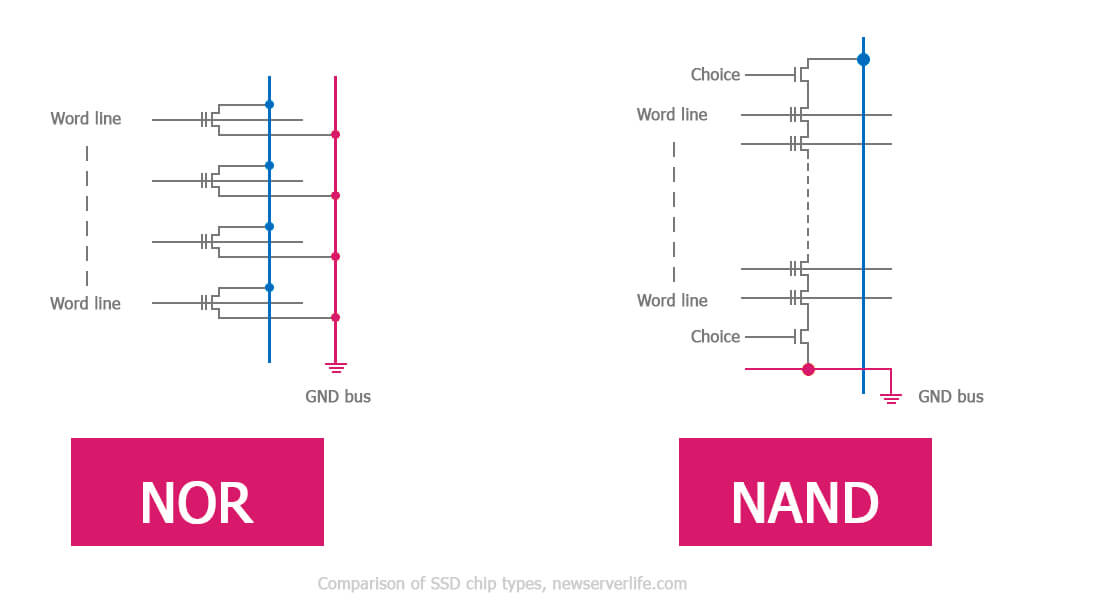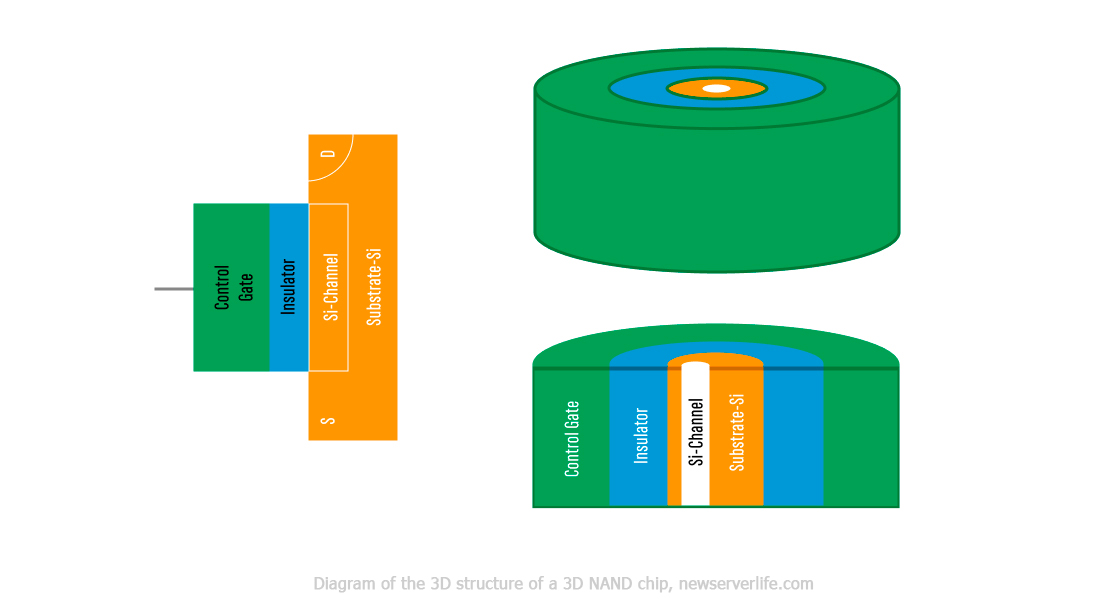Using the solid state drives speeds up the servers distinctly. SSDs are smaller than HDDs with quieter and they are more resistant to the external damage. Most important fact that the solid-state drives are becoming cheaper too fast while increasing capacity.
Let's talk about the types and standards of SSD format with storage devices and also figure out which ones to choose for a server and what to look for.
NAND и NOR
There are different types of SSD. For example, NAND and NOR (short for Not AND and Not OR).
The principles of operation the NOR and NAND chips schematically look like that:

NOR gives an access to each concrete cell, allowing write the data there. In the NAND variant, single memory cells connected in series. Writing the information to one of them it is necessary that all others have to be open.
NOR and NAND currently almost don’t compete with each other because their properties are used in various fields.
The speed characteristics of NAND technology are too high. It is possible to increase the amount of memory without increasing the size of the chip. Therefore, it is often used for storing the large amounts of data and for transferring them. The most common devices that use NAND technology include the flash drives and the memory cards.
SLC и MLC
Now let's look at the differences NAND memory. All of it can be divided into two varieties: SLC and MLC.
SLC (from Single Level Cell - single-level cells) are classic memory elements. Each of them can store 1 bit of information. Such memory is durable and energy efficient. Despite of the undeniable advantages over any other category the flash memory is with the maximum service life and with the maximum number of rewrite cycles. But the main drawback is also very significant: the low information density makes this memory the most expensive on the market.
MLC technology (Multi Level Cell - multi-level cells) is much cheaper. It offers higher storage capacity but with shorter lifetime, with slower speeds and with longer access times.
Among the multi-level cells are distinguished:
- MLC is a storage device that can store 2 bits of the information. There is interact with the data MLC slower than with SLC: it takes more time to write two bits to a cell instead of one. In addition, as the number of bits increases, the durability and reliability of SSDs decreases. However, all above disadvantages of MLC memory fully compensated by more affordable cost. At the moment, this technology demonstrates the optimal balance between speed, resources and price.
- eMLC is the similar to MLC structure but it has an increased resource. Its keep more write cycles and design for corporate purposes. The letter "e" in the name - from the English (Enterprise).
- TLC (Triple Level Cell) — 3-level cells that can store 3 bits of data. They are distinguished by a higher information density and at the same time with the lower resources and with the speed characteristics compared to MLC. TLC-based memory is less expensive to production. This fact ultimately leads to a reduction the cost of SSDs.
- QLC (Quad Level Cell) — 4-level cells where 4 data bits are placed. In terms of price per gigabyte of information the SSDs with QLC memory are approaching HDDs. They recommended when the budget is limited.
| Flash type | SLC | MLC | TLC | QLC |
| Bit per cell | 1 | 2 | 3 | 4 |
| TBW | 100 000 | 3 000 | 1 000 | 500 |
| Reading time | 25 μs | 50 μs | 75 μs | 110 μs |
| Recording time | 200–300 μs | 600–900 μs | 900–1350 μs | 1500 μs и более |
| Erase time | 1,5-2 ms | 3 ms | 4,5 ms | 7 ms |
3D NAND
3D NAND memory has a three-dimensional structure and therefore contains too much information per unit area.
It is a cylinder allows place the several memory cells on each layer of the microcircuit.
Three-dimensional flash memory differs from its two-dimensional counterparts in higher speed and it is too less under running-out. Its capacity and reliability are comparable to those of TLC memory.

Summing up
What kind of SSD is needed for a server? Ideally, it should be a fast and reliable SLC SSD. However, the final decision of this issue will depend on the concrete tasks and on the funds that you are going to invest.
The advantages of SLC technology are in the speed and in the durability. But there are also disadvantages: their production is the most expensive and the storage capacity is almost small. SLC is primarily suitable for industrial use and high-intensity workloads.
Choosing an SSD for a server, its need to choose between SLC and eMLC. In terms of reliability the eMLC is between SLC and MLC. At the same time it costs slightly more than MLC. The optimal application of eMLC is the workstations and the server platforms of the middle class.
Can MLC, TLC or QLC be usable for the server? Under certain conditions and with some reservations, yes. Is this recommended? No.




